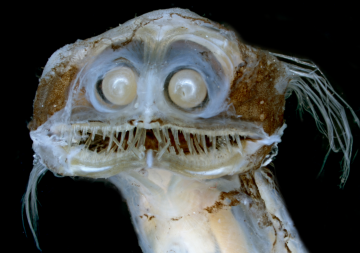730324_Telescopefish_360 px width.png

Telescopefish use their big, binocular-like eyes to detect prey in the dark ocean depths. Image courtesy of Dr. G. David Johnson, Smithsonian Institution.
The telescopefish has a cast-iron stomach. Not only can the stomach digest prey that’s bigger than the telescopefish itself, but it’s as dark as cast iron. That prevents the fish’s prey from getting revenge by attracting critters that might eat the telescopefish.
There are two known species of telescopefish. Members of both species are small—no more than about six to eight inches long. They’re found in fairly warm waters around the world, at depths of a third of a mile to a mile and a half or so.
Little or no sunlight reaches that far down. So the fish has developed sensitive eyes that poke outward from the head like a pair of binoculars or long telescopes—hence the name “telescopefish.” It may use those peepers to see the faint silhouettes of prey above it. It may glide through the water vertically so it can keep its eyes aimed upward. In addition, it can see fish and other prey that produce their own light, shining through the darkness.
When it spies a meal, the telescopefish grabs hold with a mouthful of sharp teeth. It can extend its jaw so wide that it can swallow prey up to twice its own size.
Such big prey are folded in half inside the stomach. But the telescopefish is translucent, so its glow-in-the-dark meals might attract the attention of predators. To prevent that, its stomach is black and opaque—like a blackout curtain or a cast-iron skillet. So its prey remains hidden—protecting the telescopefish in the dark ocean depths.

